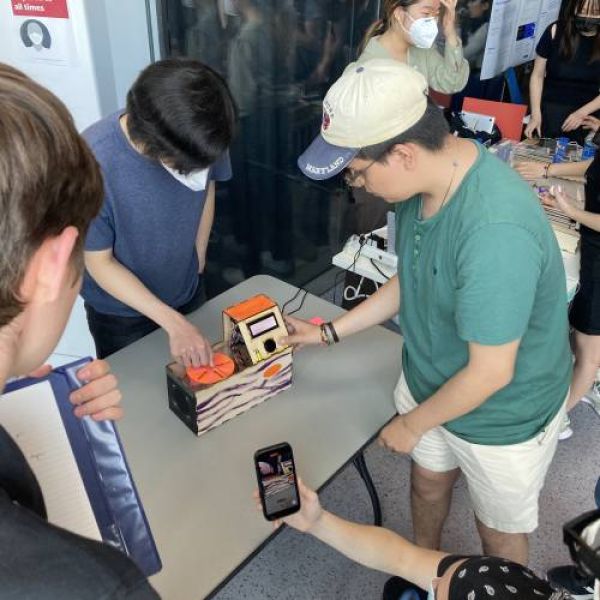May 23, 2022
By Louis DiPietro
Forty-seven projects from innovators in four Information Science courses filled the Gates Hall atrium on Thursday, May 12, as part of a massive semester-end showcase in hardware, software, design, and usability.
The four participating courses were:
- INFO 4320 – Introduction to Rapid Prototyping and Physical Computing, led by Cheng Zhang, assistant professor of information science
- INFO 4340 – App Design and Prototyping, led by Kyle Harms, lecturer in information science
- INFO 4400 – Qualitative User Research and Design Methods, led by Gilly Leshed, senior lecturer in information science
- INFO 4420 – Human Computer Interaction Studio, led by François Guimbretière, professor of Information Science
Below is a sampling of some of the projects.
INTRODUCTION TO RAPID PROTOTYPING AND PHYSICAL COMPUTING
The “Automated Lego Sorter” uses computer vision for a modern, souped-up version of a grab-and-lift mechanical system.
In a demonstration with two Legos, Nathaniel Chin ’23, a computer science major, quickly tapped out a few keys on a nearby laptop. The system snapped a photo of the scattered Legos to identify each Lego piece’s position, color, and orientation. Next, Chin tasked the system with finding the green Lego, and the Automated Lego Sorter hummed to life, automatically fetching the green Lego and dropping it into a bin with the other greens.
Chin, Alex Kyaw, Cameron Hamidi, and Youhan Yuan designed and developed the sorter.
What proved the most challenging part of the design?
Everything, they said.
“Trouble-shooting between the wiring versus the software and not knowing which was the issue,” said Kyaw, who worked on the system’s wiring, gantry, and grabber. Other challenges included “the computer vision and not being able to see certain colors because of lighting conditions.”
Nearby, Yixin Zhang, Alafia Ayeni, and Linda Li showcased their “Musical Flower” – a hybrid flower and music box. Equipped with a sensor, the Musical Flower changes pitch, the interior flower opens and closes, and adorning, motorized flowers rotate as a person moves closer or further away from the device.
“We wanted it to be a musical instrument and aesthetical,” said co-creator Zhang, a master of professional studies (MPS) student in information science.
APP DESIGN AND PROTOTYPING
This semester, the App Design and Prototyping course teamed up with the College of Human Ecology for a collaborative project called “Playful Plants.” Ten student teams designed apps to encourage and support play in gardening spaces for children.
Teammates Han Gao, Helen Jing, and Daisy Liu – all MPS students in information science – developed an app with families in mind. The app includes a searchable plant catalogue and gardening journal, where families can post photos of their gardening adventures. Since the team consists of graduate students, they were also required to develop a responsive version of their app for mobile devices.
While noting its challenges, Liu said she appreciated the hands-on experience of App Design and Prototyping, a studio course with few traditional lectures and an emphasis on self-directed learning.
“It was challenging to learn and build at the same time,” she said. “I liked the experience of learning by doing. It’s useful but challenging.”
Added Gao: “The whole process of implementation is rewarding. Kyle [Harms] encouraged us to explore the whole process by ourselves.”
QUALITATIVE USER RESEARCH AND DESIGN METHODS
For the Qualitative User Research and Design Methods course, Marcus Fang – an MPS student in information science – and his teammates Arthur Tan and Ryun Shim developed “Boost,” a novel promotion service aimed at elevating student musicians and their music in public areas on campus.
“This is for a space like this,” said Fang, motioning to the bustle of the Gates atrium, “100 or 200 people are in the same room, in a campus setting. We’re trying to connect musicians with their peers.”
Elsewhere, “Closet, Clothes & Clutter” is a “closet management experience” designed for students. Created by Yulu Cao, Han Bing Hu, Kay Zhang, and Jingwen Zhu, the “closet enhancement kit” – a prototype, modular clothes rack with a laundry scheduler and weather indicator – draws on the team’s research via student surveys, interviews, and autobiographical design, which showed three main findings: students have limited space and time for clothes management; they approach their clothes and closets in an informal, casual way, and individuality reigns.
“Different people have different ways to manage their clothes. There’s no one-size-fits-all solution for everyone,” Zhang said.
HUMAN COMPUTER INTERACTION STUDIO
Yunqin Wang, Juran Li, Minwei Jiang, and Seonghee Lee tackled what’s known as the “Last 100-meter Problem” in the field of autonomous vehicles, namely how can passengers communicate to an autonomous vehicle that they’d like to get dropped off one block up or have the car pull over here, not there? Their design concept would transform the vehicle’s windshield into a mixed reality, interactive, gesture-sensing display.
“Our design is to explore nuances, the micro interactions, that will happen when a passenger rides in an [autonomous vehicle], including customizing a new route or adjusting the route due to unexpected situations on the road,” said Li, an MPS student in information science. “The GPS location may not be exactly where you want to be dropped off. So you’ll tell the driver, ‘Go another 100 feet and drop me off.’ With an autonomous vehicle, without a driver, it’s a problem. How do you specify exact location?”
Through gestures interpreted by the interactive system – like pointing toward an open parking area just short of the intended destination – passengers would have the means to convey information to an autonomous vehicle.



